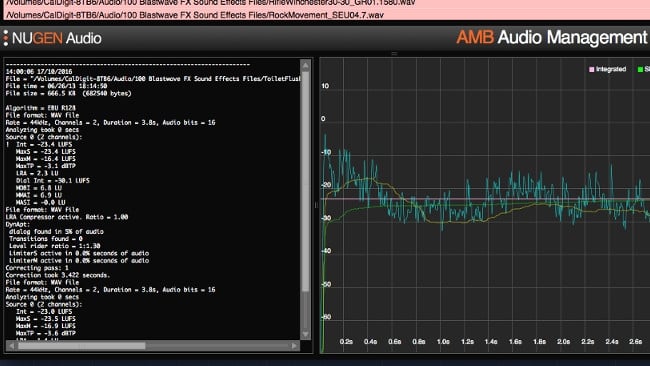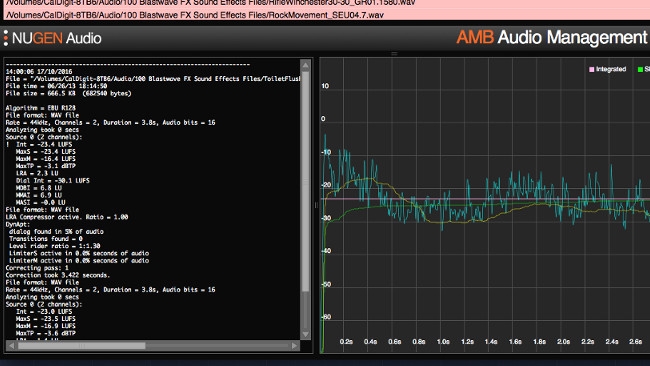
 NUGEN Audio AMB
NUGEN Audio AMB
We take an in-depth look at NUGEN Audio's Audio Management Batch Processor (AMB), a stand-alone app for loudness reporting and correction for loudness standards. By Erik Vlietinck.
NUGEN Audio recently released a batch processor, Audio Management Batch Processor (AMB). This stand-alone app processes multiple audio files simultaneously. Its primary concern is to report on loudness levels; its secondary is to auto-correct your files for loudness standards. A third module will upmix your audio using the new Halo Upmix algorithm. AMB will optionally also work with ProRes and MXF files (OP-1a and OP-Atom).
Features and usage
As stated above, the NUGEN Audio AMB Processor app reports on the loudness characteristics of your files. It's based on queues that can be run serially or in parallel with individual settings. In its current state of development, AMB has two extra modules for which you may purchase a licence: upmixing and ProRes capabilities. The upmixing module works with NUGEN Audio's Halo Upmix technology, which is also available as stand-alone application. If you have it on your system, AMB can currently load the presets you create in Halo Upmix by copying the files in the Finder. The ProRes module has no settings at all. It just works.
NUGEN Audio AMB Processor has a flexible licensing system. When you buy a standard licence, you'll get two queues and two threads. If you need more power, you can buy extra queues and threads. My test licence came with seven queues and nine threads. I experimented with one, two and three queues and must say the app was blazingly fast, processing 993 small files, typically between 10sec and 3min.
The reporting functionality saves a detailed text or XML report. If you want, you can also have the app generate and save a PNG graph image with full loudness information. To comply with loudness industry standards, files can be corrected for six standards. Correction can work both ways: up for very quiet files and down for loud files. In addition, you can auto-adjust the dynamics of the file using NUGEN Audio's excellent DynApt algorithm. Three types are supported here: TV, podcast and custom. To correct files, you must check the Auto-correct checkbox; otherwise, the app will only report on loudness. The checkbox should, in my opinion, be in a more prominent place. It's easy to overlook.
If you choose to correct your files, the application will, in some cases, start an iterative correction round. It will apply small corrections until the file complies with the desired loudness settings. This iterative correction is unusual in common usage. It only happens if the limiter is very active during the processing. That usually only happens if you are correcting audio to be much louder or silent than the original file is.
Regardless, AMB Processor never introduces sound artefacts. The end result of all the files I put through AMB's audio processors was impeccable, even for the noisiest ones.
A modular queue system
NUGEN Audio AMB Processor has a tabbed interface. Each tab represents a queue. Each queue has its own settings. Having multiple queues means you can have AMB process files differently, all simultaneously.
AMB allows you to process files automatically, as soon as you or another app dumps them in a watch folder or straight in the queue window. You can then route processed files to any folder you designate in the queue settings. I tested to see if I could set up chain processing, where you start with adding files to one watch folder and route them to the watch folder of the next queue, and so on. It worked fine. You do need to think over your 'File Handling' settings carefully.
You can also send files to all queues at once by dropping files in the 'All Queues' tab that auto-magically becomes available if you have multiple queues set up. Such a workflow would make a lot of sense if you use the same audio files for different purposes. For example, having a queue for DynApt for TV and another for podcasting lets you output both results at once. This worked like a charm.
Upmixing worked like a charm, too. You can upmix to new files or 'inline'. The latter requires an audio file with enough channels to contain the upmixed audio. There's an option to configure the routing of channels from the original file. The process is pretty straightforward. The upmixing feature results in perfect sounding files, with a distribution of loudness across the channels, depending on your settings.
The ProRes and MXF modules allow you to natively process video files with metadata and PCM audio. When correcting for loudness, you'll end up with video files that comply with the settings you selected for the queue. However, if you choose to upmix the video file, you will end up with a WAV audio file if you set your queue to create a new file. If you have a MOV file with eight channels, you can upmix the video file itself. MXF files have a few options you can set, such as whether you want to update the metadata and/or enable AS-11 UK DPP checks.
NUGEN Audio AMB Processor is squarely aimed at broadcasting companies, streaming service providers and production houses. I think small online providers of sound effect files and video music could benefit from the NUGEN Audio AMB Processor as well. The core NUGEN Audio AMB Processor app costs around €799. Extra queues and threads cost €399/pc.
Tags: Audio



Comments